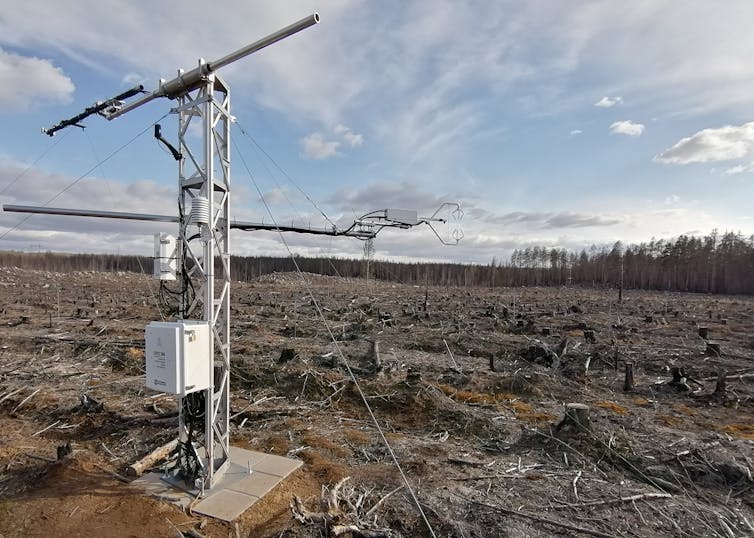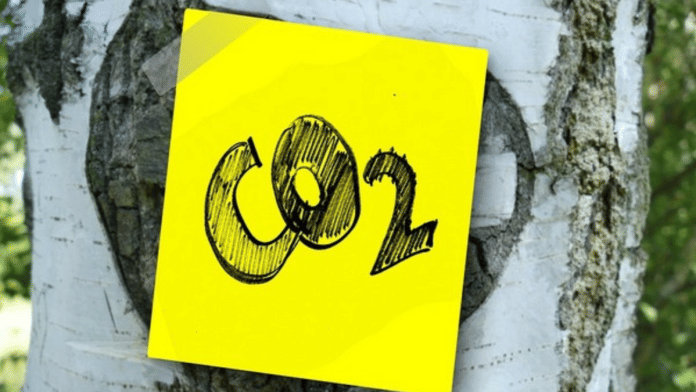Earth’s far north hosts the boreal forest, a vast green belt that stretches from North America to Siberia. The boreal forest is one of the world’s largest CO₂ sinks. Over the past few thousand years it has removed around 1 trillion tonnes of carbon from the air, storing it in the trees and soil. Because of the large amount of carbon stored in the boreal forest, fires here can release much more CO₂ into the air than forest fires elsewhere, amplifying climate change.
Wildfires release lots of climate-warming CO₂ while they rage. But our research in the European part of this forest has shown that the forest’s CO₂ sink recovers slowly, with the burnt area continuing to release CO₂ for several years after the fires die. This exceeds the amount of CO₂ produced from the fire itself.
A large CO₂ store is in danger
Extremely hot and dry weather in 2018 led to the largest number of wildfires in the Nordic countries in modern history. In Sweden, the total burnt area was ten times larger than in an average year.
Our research concentrated on the most extensive of these fires in the very centre of Sweden, near Ljusdal. We continuously measured how much CO₂ was exchanged between the land surface and the atmosphere and monitored the soil and regrowth of vegetation during the first four years after the fire.
We did this in areas of forest where the trees were killed and areas where trees survived. We also compared areas that were turned into nature reserves – with charred trees left standing – and areas that underwent typical post-fire management in Sweden, with all charred trees being cut (so-called “salvage logging”) and new ones planted.

Our measurements from some of the most degraded sites, namely a burnt forest after salvage logging and a young forest where all trees were killed during the fire, revealed that 650g of carbon was emitted on average from every burnt square metre during the first four years after the fire. This more than doubles the total emissions from the fire. For comparison, a similar unburnt forest would remove 1,200g of carbon from the air per square metre during the same time.
And the emissions continue. We fed the data we collected from burnt sites and other Swedish boreal forest into a computer model that simulates tree growth. The model predicted that it would take more than 40 years for all the CO₂ that was emitted due to the 2018 fire to be stored again in new forest.
What about elsewhere?
Fires in the boreal forest of North America are well studied, but this knowledge is less easily applicable in Europe. North American wildfires tend to rise up into the forest canopy and hence they kill lots of trees. During such fires, most of the carbon emissions happen during the fire itself.
Meanwhile, between 60 and 80% of the forested area of the Nordic countries is intensively managed for commercial forestry, which changes the way wildfires affect the forest. Forest management can involve the removal of dead plant material and regular logging to ensure that the trees don’t grow too close to each other, a practice known as “thinning”.
Tree species vary between the two continents too: North American boreal trees need fire to reproduce, whereas their European equivalents have evolved to resist burning.
As a result, wildfires in the managed boreal forest of the Nordic countries mostly stay near the ground and consume the soil and undergrowth, sparing many trees.
Post-fire management is critical
We also found that further disturbing the burnt forest – with salvage logging or by ploughing the soil before replanting trees, which is a common management procedure in Sweden – slows the recovery of vegetation. If surviving trees are left standing they might grow more slowly than unburnt trees but they are nevertheless continuously capturing and storing CO₂.
The way a forest is managed after a fire affects how long it takes before enough new vegetation grows to turn the forest back into a carbon sink. From this point of view, our findings dispute the effectiveness of logging surviving trees.
In the Nordic countries, especially in Sweden, intensive forest management has successfully supressed wildfires during the past 200 years. It is not clear whether this will still be possible with more frequent droughts and an increased fire risk expected in a warming climate.
All of this relates to scientific understanding of how wildfires contribute to climate change. As CO₂ emissions continue during the slow recovery of vegetation and soil post-fire, climate modellers should not only consider emissions from the fire itself, but the additional long-term emissions our research has uncovered.

Get our award-winning weekly roundup in your inbox instead. Every Wednesday, The Conversation’s environment editor writes Imagine, a short email that goes a little deeper into just one climate issue. Join the 35,000+ readers who’ve subscribed so far.
Natascha Kljun, Professor in Environmental Science, Lund University and Julia Kelly, Postdoctoral Fellow, Centre for Environmental and Climate Science, Lund University
This article is republished from The Conversation under a Creative Commons license. Read the original article.






